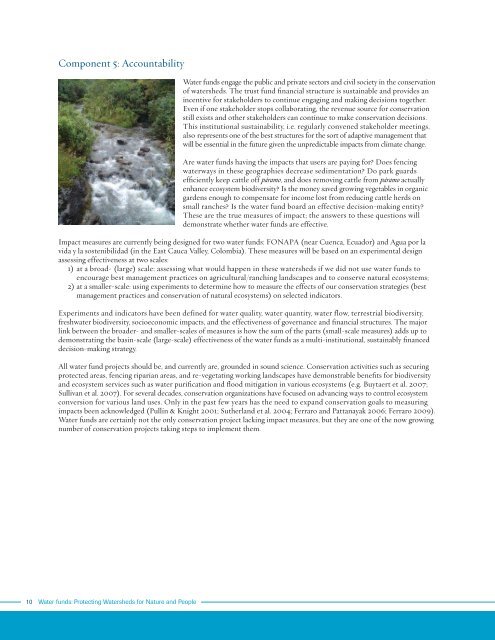Water Funds - Natural Capital Project
Water Funds - Natural Capital Project
Water Funds - Natural Capital Project
- No tags were found...
You also want an ePaper? Increase the reach of your titles
YUMPU automatically turns print PDFs into web optimized ePapers that Google loves.
Component 5: Accountability<strong>Water</strong> funds engage the public and private sectors and civil society in the conservationof watersheds. The trust fund financial structure is sustainable and provides anincentive for stakeholders to continue engaging and making decisions together.Even if one stakeholder stops collaborating, the revenue source for conservationstill exists and other stakeholders can continue to make conservation decisions.This institutional sustainability, i.e. regularly convened stakeholder meetings,also represents one of the best structures for the sort of adaptive management thatwill be essential in the future given the unpredictable impacts from climate change.Are water funds having the impacts that users are paying for? Does fencingwaterways in these geographies decrease sedimentation? Do park guardsefficiently keep cattle off páramo, and does removing cattle from páramo actuallyenhance ecosystem biodiversity? Is the money saved growing vegetables in organicgardens enough to compensate for income lost from reducing cattle herds onsmall ranches? Is the water fund board an effective decision-making entity?These are the true measures of impact; the answers to these questions willdemonstrate whether water funds are effective.Impact measures are currently being designed for two water funds: FONAPA (near Cuenca, Ecuador) and Agua por lavida y la sostenibilidad (in the East Cauca Valley, Colombia). These measures will be based on an experimental designassessing effectiveness at two scales:1) at a broad- (large) scale: assessing what would happen in these watersheds if we did not use water funds toencourage best management practices on agricultural/ranching landscapes and to conserve natural ecosystems;2) at a smaller-scale: using experiments to determine how to measure the effects of our conservation strategies (bestmanagement practices and conservation of natural ecosystems) on selected indicators.Experiments and indicators have been defined for water quality, water quantity, water flow, terrestrial biodiversity,freshwater biodiversity, socioeconomic impacts, and the effectiveness of governance and financial structures. The majorlink between the broader- and smaller-scales of measures is how the sum of the parts (small-scale measures) adds up todemonstrating the basin-scale (large-scale) effectiveness of the water funds as a multi-institutional, sustainably financeddecision-making strategy.All water fund projects should be, and currently are, grounded in sound science. Conservation activities such as securingprotected areas, fencing riparian areas, and re-vegetating working landscapes have demonstrable benefits for biodiversityand ecosystem services such as water purification and flood mitigation in various ecosystems (e.g. Buytaert et al. 2007;Sullivan et al. 2007). For several decades, conservation organizations have focused on advancing ways to control ecosystemconversion for various land uses. Only in the past few years has the need to expand conservation goals to measuringimpacts been acknowledged (Pullin & Knight 2001; Sutherland et al. 2004; Ferraro and Pattanayak 2006; Ferraro 2009).<strong>Water</strong> funds are certainly not the only conservation project lacking impact measures, but they are one of the now growingnumber of conservation projects taking steps to implement them.10 <strong>Water</strong> funds: Protecting <strong>Water</strong>sheds for Nature and People
















